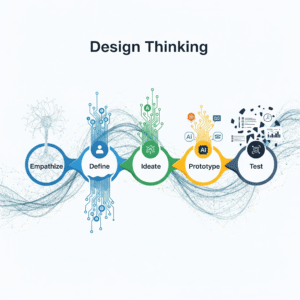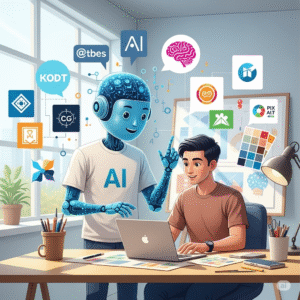The creative world is buzzing about AI art tools. For graphic designers, this technology presents both incredible opportunities and potential pitfalls. The ability to generate stunning visuals from simple text prompts is revolutionary, but navigating this new landscape requires a thoughtful approach. Diving headfirst into the world of AI for Graphic Designers without understanding its nuances can lead to underwhelming results, ethical dilemmas, and even harm to your creative workflow.
Therefore, this comprehensive guide will illuminate the common mistakes that designers make when using AI art tools and, more importantly, how to avoid them. We’ll explore how to leverage these powerful technologies effectively, ensuring that they enhance, rather than hinder, your creative process. By understanding these potential missteps, you can harness the true potential of AI for Graphic Designers and elevate your work to new heights. This journey into the world of AI-generated art will equip you with the knowledge to use these tools responsibly and effectively.
Mistake #1: Relying Solely on Default Settings (AI for Graphic Designers)
One of the most common errors new users of AI art tools make is sticking with the default settings. While these presets can produce interesting results, they often lack the specificity and control that professional graphic designers need. The beauty of these tools lies in their customizability.
Consequently, failing to experiment with different parameters, styles, aspect ratios, and negative prompts limits the output to generic imagery that doesn’t align with your unique vision or the client’s brand. Just like a traditional artist carefully selects their brushes and paints, designers using AI for Graphic Designers must learn to master the various controls to achieve truly distinctive and tailored artwork. Remember, the default is just a starting point, not the destination.
To avoid this mistake, take the time to explore the advanced settings of your chosen AI art tool. Experiment with different prompt weights, sampling methods, and seed numbers. Understanding how these parameters influence the final image is crucial for unlocking the tool’s full potential and creating truly original pieces that stand out.
Mistake #2: Poor Prompt Engineering (AI for Graphic Designers)
The saying “garbage in, garbage out” is particularly relevant when it comes to AI art tools. The quality and specificity of your text prompts directly dictate the quality and relevance of the generated artwork. Vague or generic prompts will inevitably lead to equally uninspired results.
Therefore, effective prompt engineering is a fundamental skill for any graphic designer incorporating AI into their workflow. This involves using clear, concise language and including specific details about the desired style, subject matter, mood, color palette, and composition. Think of your prompt as a detailed brief to a human artist; the more information you provide, the better the outcome will be. Mastering prompt engineering is a cornerstone of successful AI for Graphic Designers.
To improve your prompting skills, try breaking down your desired image into key elements. Instead of simply typing “a futuristic city,” try “a vibrant, cyberpunk-style cityscape at night, with neon signs reflecting off wet streets, a sense of bustling energy, and a dark teal and magenta color scheme.” The more descriptive you are, the closer the AI will get to your intended vision.
Case Study: The Evolution of Prompting for a Marketing Campaign
A small marketing agency was tasked with creating visuals for a tech startup’s new product launch. Initially, their graphic designer used simple prompts in an AI art tool, such as “abstract technology background.” The results were visually appealing but lacked a connection to the brand’s identity and the product’s features.
Consequently, after realizing this limitation, the designer refined their prompting strategy. They started including specific keywords related to the product’s functionality, the company’s futuristic branding, and the target audience’s aesthetic preferences. Prompts evolved to become more detailed, such as “a minimalist abstract design representing interconnected networks, using a vibrant electric blue and a clean, modern style, evoking innovation and connectivity.” This refined approach led to visuals that were not only aesthetically pleasing but also aligned perfectly with the brand’s message, demonstrating the power of thoughtful prompting in AI for Graphic Designers.
The Quantum Leap: How Quantum AI Impact Will Reshape Future Professions
Mistake #3: Ignoring Copyright and Ethical Implications (AI for Graphic Designers)
The legal and ethical landscape surrounding AI art tools is still evolving, and it’s crucial for graphic designers to be aware of the potential pitfalls. One significant mistake is generating and using AI art without considering copyright issues or the ethical implications of using algorithms trained on vast datasets of existing artwork.
Therefore, understanding the terms of service of the AI art tool you are using is paramount. Some platforms grant users commercial rights to the generated images, while others may have limitations. Furthermore, the ethical considerations of using AI trained on the work of human artists without their explicit consent are a subject of ongoing debate within the creative community. Responsible AI for Graphic Designers involves navigating these complexities with care and awareness.
To mitigate these risks, research the licensing terms of your chosen AI art tools. Consider exploring platforms that explicitly address copyright ownership and the origin of their training data. Additionally, be mindful of potentially replicating existing artists’ styles too closely, which could lead to ethical concerns and potential legal issues down the line.
Mistake #4: Over-Reliance and Neglecting Foundational Skills
While AI art tools can be incredibly powerful, they should be seen as augmentations to a graphic designer’s skillset, not replacements for fundamental design principles. A significant mistake is becoming overly reliant on AI and neglecting to hone essential skills such as composition, color theory, typography, and visual hierarchy.
Therefore, a strong understanding of these core design principles is crucial for effectively guiding AI art tools and refining their output. Without this foundation, designers risk generating aesthetically pleasing but ultimately ineffective visuals that lack strategic intent and fail to communicate their intended message. True mastery in the age of AI for Graphic Designers involves blending technological capabilities with timeless design wisdom.
To avoid this pitfall, continue to practice and develop your core design skills alongside your exploration of AI tools. Use AI-generated images as a starting point, and then apply your expertise to refine, iterate, and integrate them into your overall design projects. Remember that AI is a powerful assistant, but your creative vision and technical skills are still essential.
Case Study: Blending AI with Traditional Design at a Branding Agency
A branding agency decided to experiment with incorporating AI art tools into their workflow. One junior designer, excited by the technology, began generating logos and brand assets solely through AI prompts, neglecting the agency’s established design process and brand guidelines. The resulting designs, while visually interesting, lacked strategic alignment and failed to capture the essence of the clients’ brands.
Consequently, the agency implemented a new protocol that required designers to use AI as a starting point for ideation and exploration, but emphasized the importance of applying their design expertise to refine and customize the AI-generated visuals. Senior designers provided feedback based on established design principles and brand strategy. This blended approach allowed the agency to leverage the speed and novelty of AI while ensuring the final deliverables were strategically sound and visually cohesive, highlighting the importance of integrating AI for Graphic Designers thoughtfully within existing workflows.
Key AI Tools for Graphic Designers
Several AI art tools are available, each with its strengths and unique features. Here are a few notable examples:
- Midjourney: Accessible through Discord, Midjourney is known for its ability to create highly artistic and imaginative imagery from text prompts. It’s a favorite among digital artists for its evocative and often surreal results.
- DALL-E 2 (OpenAI): Developed by OpenAI, DALL-E 2 excels at understanding complex prompts and generating realistic and coherent images. It also offers features like inpainting and outpainting for more precise image editing. OpenAI DALL-E 2
- Stable Diffusion: An open-source AI art tool that offers a high degree of customizability and control. Its accessibility and flexibility have made it a popular choice for designers who want to fine-tune the image generation process.
- Adobe Firefly: Integrated directly into Adobe Creative Cloud applications, Firefly aims to seamlessly blend AI-generated art with existing design workflows, offering features like generative fill and text-to-image within familiar tools like Photoshop. Adobe Firefly
- AI Robotics in Industry Are Redefining Manufacturing and Logistics
Outbound links to explore further:
- HubSpot Blog: The State of AI in Marketing (While focused on marketing, it provides broader context on AI adoption)
- Wired: The Messy Ethics of AI Art (Provides insight into the ethical considerations of AI art)
Best Practices for Using AI Art Tools Effectively
To truly harness the power of AI for Graphic Designers, consider these best practices:
- Iterate and Refine: Don’t expect perfect results from the first generation. Use AI as a starting point and iterate on the output through multiple prompts and manual editing.
- Combine with Traditional Tools: Integrate AI-generated visuals with your existing design software (like Adobe Photoshop or Illustrator) for further refinement and integration into your projects.
- Stay Updated: The field of AI art tools is rapidly evolving. Keep learning about new features, techniques, and ethical considerations.
- Develop a Personal Style: Experiment with different prompting techniques and parameters to develop a unique artistic voice within the AI medium.
By avoiding these common mistakes and adopting these best practices, graphic designers can effectively integrate AI art tools into their workflow, unlocking new creative possibilities and enhancing their ability to deliver innovative and impactful visuals. The future of design is a collaborative one, where human creativity and artificial intelligence work hand in hand.
AI Hyper-Personalization is Revolutionizing Professional Services
AI for Graphic Designers, AI art tools, generative AI, prompt engineering, AI design, AI in graphic design, ethical AI art, copyright AI art, Midjourney mistakes, DALL-E 2 tips, Stable Diffusion guide, Adobe Firefly use, digital art workflow, creative AI, AI design process, avoiding AI art pitfalls, best AI for designers, AI image generation, text to image design, AI enhanced design.



